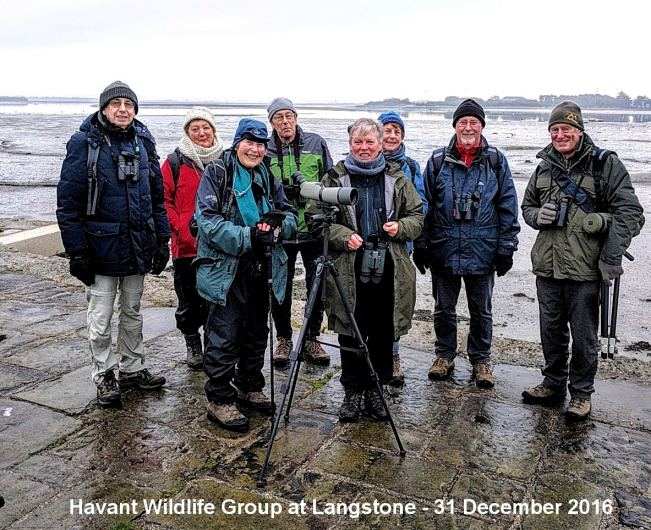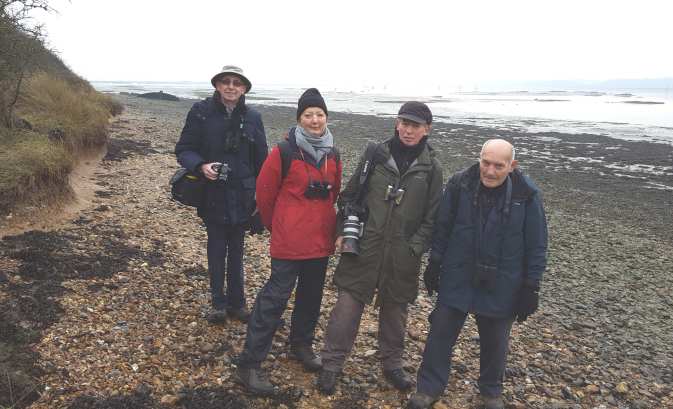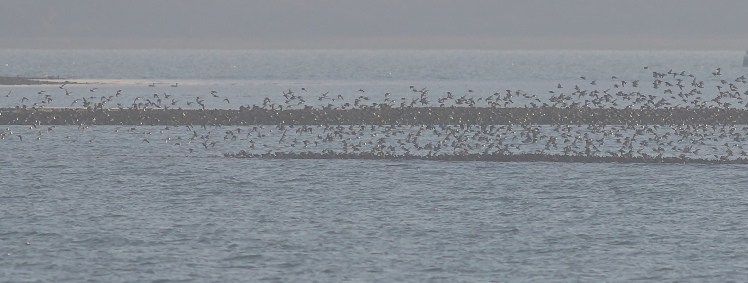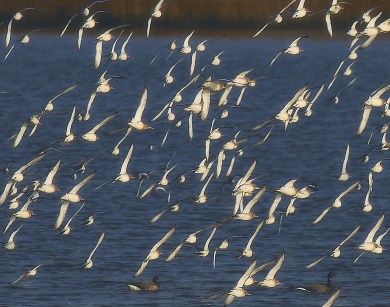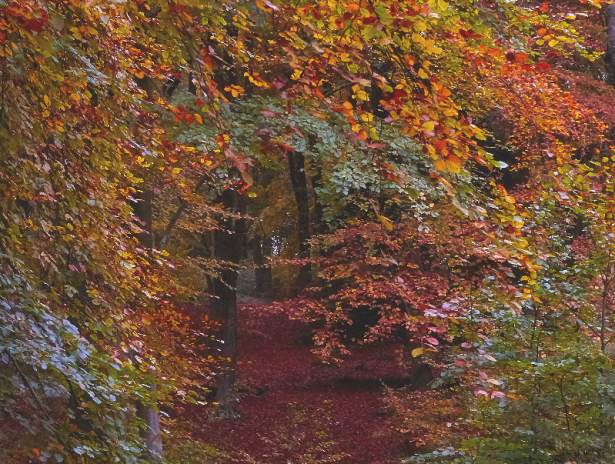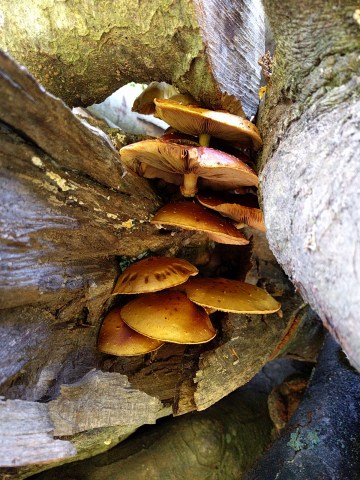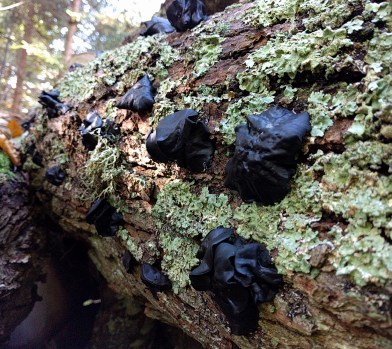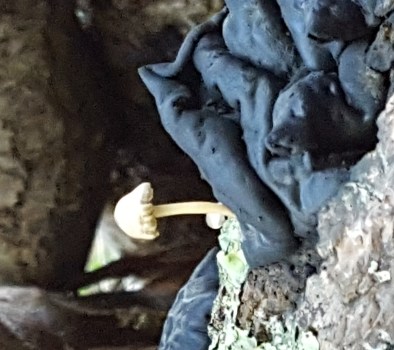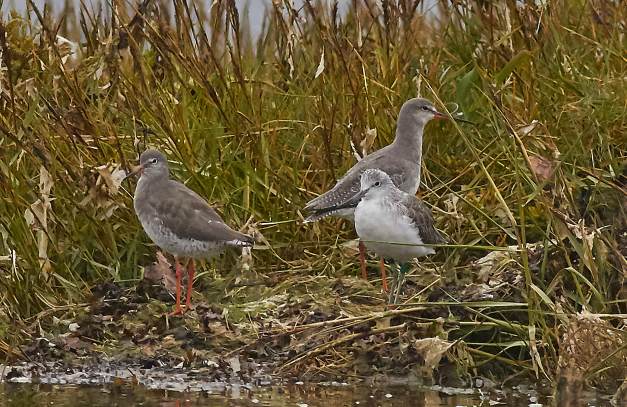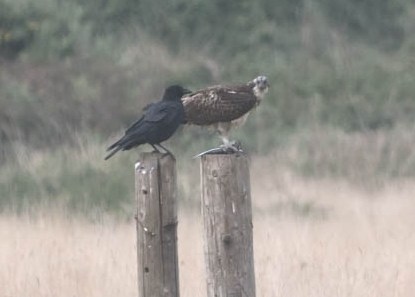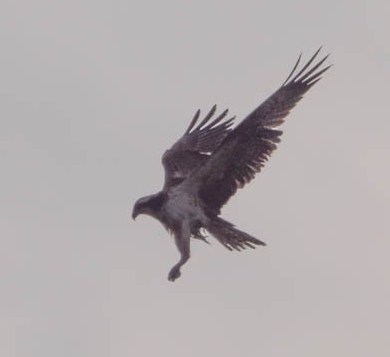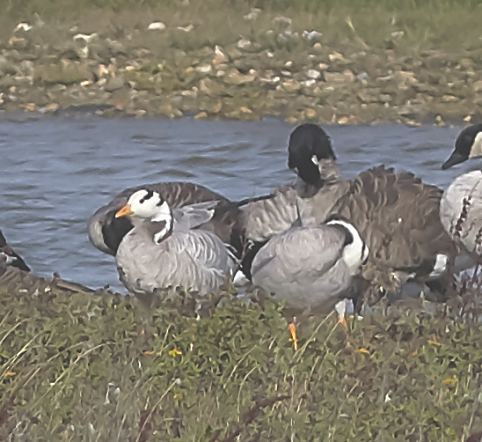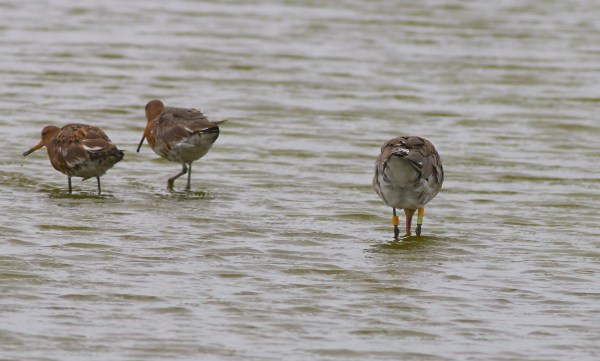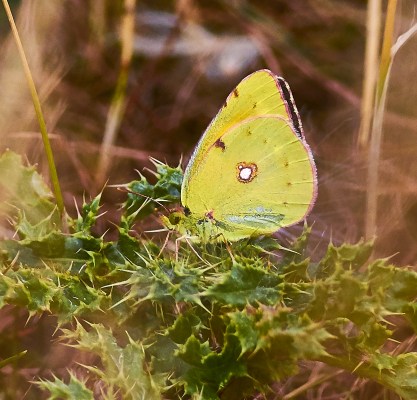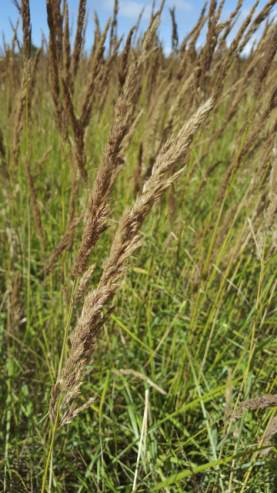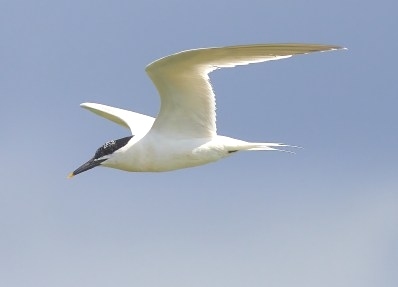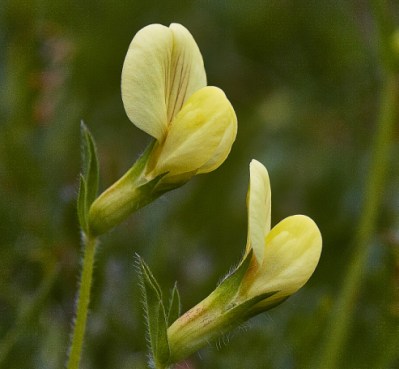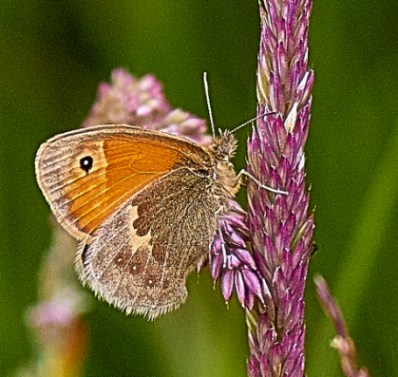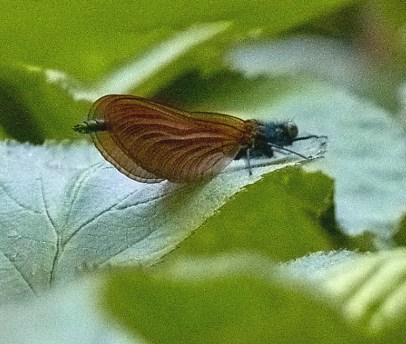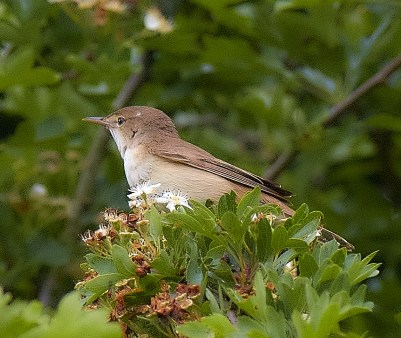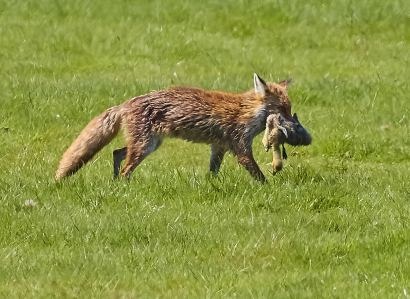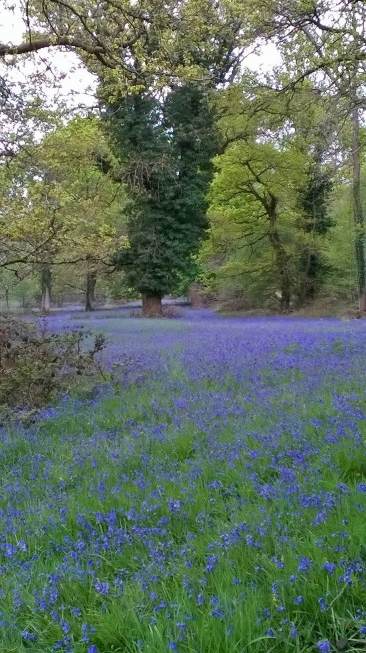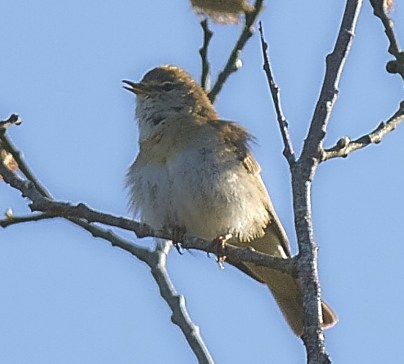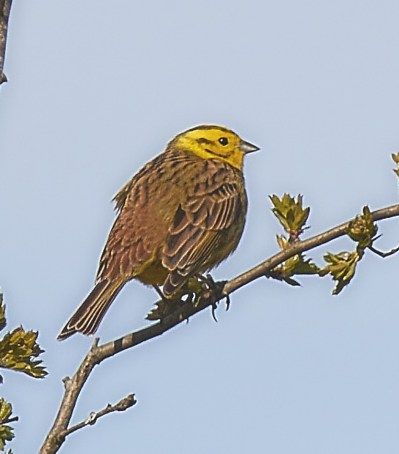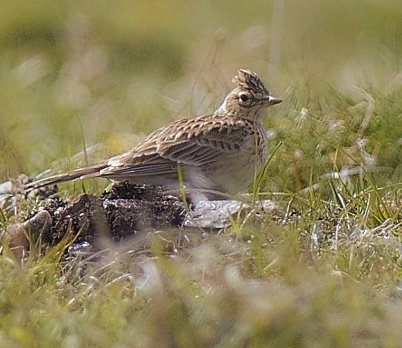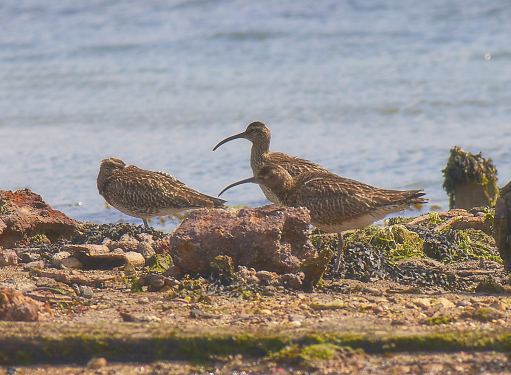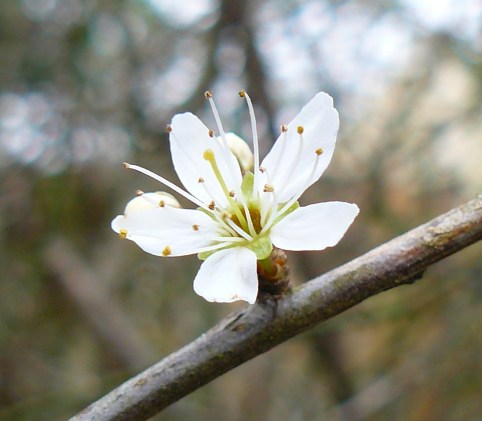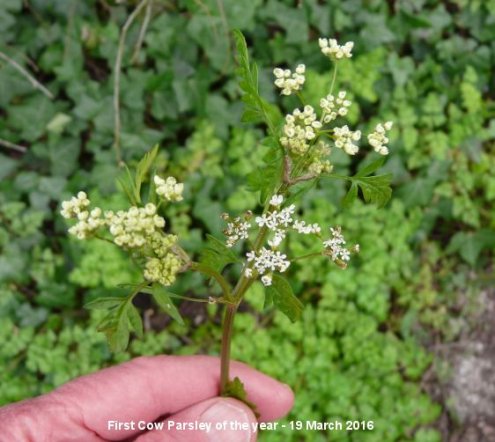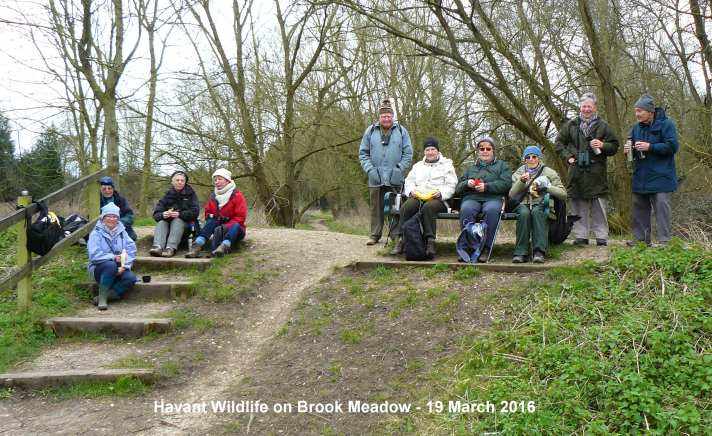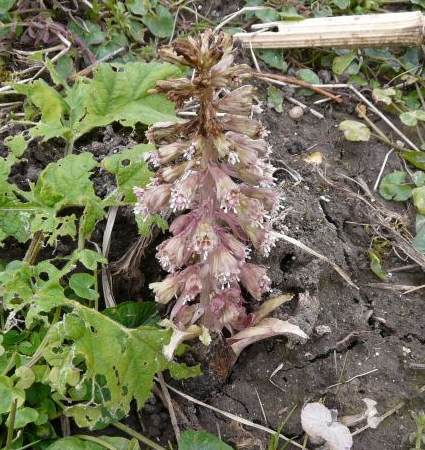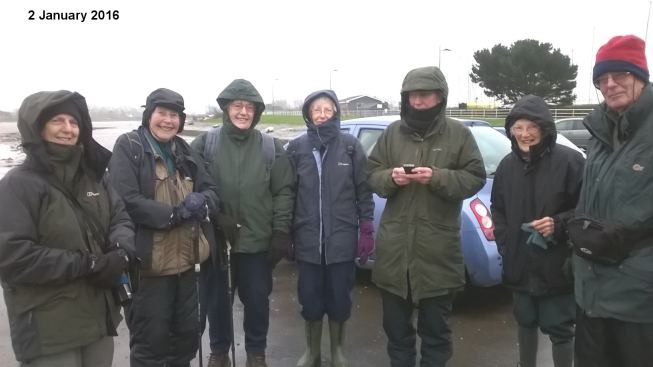HAVANT WILDLIFE GROUPREPORTS OF SATURDAY WALKS for 2016
for earlier years see . . . Havant Wildlife Group -main page. . . .
SATURDAY DECEMBER 31 - Langstone - Warblington
Heather Mills reports on this morning's walk by the Havant Wildlife Group.
On a decidedly foggy morning 9 turned up in anticipation of the likelihood of seeing any birds through the mist. Thanks to Derek for taking the photo.Thankfully the fog lifted and we had 46 species. We met up with Peter Milinets-Raby who pointed out a distant Curlew sandpiper on the shore as the tide crept in. Our first good sighting was 4 male and female Red Breasted Mergansers in the creek, with a close view of a female avidly diving.
We proceeded around the shore line past the Royal Oak and heard two Herons calling as they flew into the top branches of the trees on the pond. Peter commented that they were starting to nest already. Certainly there was an air of spring about as Blue and Great tits sang and a Skylark twittered briefly above as the sun came out. We headed off to Warblington Churchyard to have our break and possibly catch up with the Cattle Egrets.
After our break listening to a delightful Song Thrush in a Yew tree, we sent "scouts" looking for the Egrets. Ros came up trumps with some showing in a distant field beyond the castle. As if by design, as we peered into the distance, four flew into the field right next to us. Also a good flock of 20 plus Redwing to give added pleasure. Stock doves in the old Oaks gave a us good views of their blue hue colour, but no luck finding the Little Owl.
As we retraced our steps we had a fitting finale, with the Water rail giving fine views right in front of us. Not long enough for a photo alas. Couple of pictures showing the group.A full report of the birds seen by Peter Milinets-Raby this morning is on the Emsworth wildlife blog at . . .
http://familyfellows.com/0-0-0-wildlife-diary.htm
SATURDAY DECEMBER 17 - Portchester Castle
Des Barker reported on this morning's walk by the Havant Wildlife Group.Five of us gathered at Portchester Castle car park on a very misty and damp morning. One could hardly see across the Harbour to Gosport and Portsmouth. The Spinnaker Tower was just visible along with a couple of very large cranes. Here are four of us with Heather taking the picture.
The tide was just past low water with the result that the waders and ducks were a long way from the Tow path. This made making out the colours of the birds very difficult to distinguish except for Heather. Her binoculars must have a special system for transmitting colours in poor light conditions! With her considerable amount of help and patience, the rest of us finally managed to identify most of the following: Brent Geese, Shelduck, Teal, Goldeneye, Red-breasted Merganser, Great Crested Grebe, Dunlin, Redshank.
On the other side of the Tow path, were enclosed fields with large shrubs and trees scattered throughout. There were 10+ Curlew in the fields giving us an excellent view while the Green Woodpecker was not put off by our presence, and continued his ant harvesting. There were numerous other varieties listed below in the shrubs and trees. After over 2 hours, we reached the Salt café and sat outside drinking our coffee and admiring the views of the harbour as the sun was just coming out. On the return home, the sun came fully out and we had some wonderful views of the birds in the field as the sun was behind our backs. All our binoculars were distinguishing the markings and colours with Goldfinches and Song Thrushes showing up particularly well. By lunch time, it was more like a Spring day than only 4 days from the shortest day of the year.
Wishing all HWL members a happy Xmas and New Year
WEDNESDAY DECEMBER 14 - 2016 Christmas SocialThe annual Xmas Social of the Havant branch of the Hampshire Wildlife Trust was held at the Emsworth Community Centre on Dec 14. Here is a shot of members checking the answers to the wildlife quiz.
SATURDAY DECEMBER 10 - 2016 - NorthneyValerie & David Mitchell reported on today's walk by the Havant Wildlife Group
Ten enthusiastic birdwatchers met at the small Nature Reserve, St Peter's Road, Northney, on a mild, drizzly, misty morning. There were plenty of seabirds to see through our misty binoculars:- Teals, shelducks, lapwings, grey plovers, redshanks, cormorant, curlews, godwits, Brent geese, oyster catchers, dunlins, merganser/goosander ducks, egret, black-headed and black back gulls. Many of the birds were in large flocks which were regularly flying around in between feeding. A bit of sunshine would have made identification easier, but at least we didn't get very wet.
Other birds included pigeons, chaffinches, a charm of goldfinches, greenfinches, wren, robin and great tit, pied wagtail.
Plants in flower included yarrow, daisies, common stork/cranesbill and bristly ox tongue.
After a couple of hours, we drove a short distance to Northney Farm for a welcome hot drink. Unfortunately we won't be on next week's walk, but look forward to the Langstone walk on 31st December. Best wishes to everyone for a very Happy Christmas,
SATURDAY DECEMBER 3 - 2016 - NutbourneFay Durant reports on yesterday's walk by the Havant Wildlife Group
Six brave souls gathered at Farm Lane on a cloudy but pleasant morning . As Nigel forecast the sun came out at 10 am and viewing was much improved! We walked across the field to the coastal path and admired the banded Galloway which had been brought in to control the vegetation on the right. This area had been very overgrown but much had been cleared. Once on the shore we saw a wonderful selection of sea birds: the famous avocets, over twenty which took to the air to display their wing patterns - so attractive; numerous Brent geese; back tailed godwits; a selection of teal, wigeon, red shank, shell duck and, later along the shoreline, turnstones, several grey plover and one ringed plover, curlew and oyster catchers.We walked westwards towards Prinstead and noted much undergrowth had been removed, channels deepened and new fencing erected, in preparation for winter and in the hope of preventing flooding. We were delighted to see several stonechats, the colours of the males so bright in the sunshine. We watched a selection of small birds bathing in one of the channels: meadow pipits, goldfinch, a Robin etc. Derek spotted a Great spotted woodpecker in a tree, great discussion on whether it was a Great or Lesser! As we turned the corner, the wind hit us and we were pleased to reach the comparative sheltered area of Prinstead for coffee, passing the usual gathering of sparrows in the bushes. We returned to Nutbourne via the inland path, noting a little egret flying above the field and later a pied wag tail, flitting around the grass. When we reached what is left of the orchard, Neil spotted two field fare in the trees, not seen by us in this region for a while. Our last sighting was a green woodpecker under the apple trees.
There were a few flowers out: gorse, red and white dead nettl, groundsel, mayweed, bristly oxtongue, yarrow and field speedwell. A good walk for a winter morning .
SATURDAY NOVEMBER 26 - 2016 - Farlington Marshes
Jean Hildersley reported on the Havant Wildlife Group walk.
Eight plus invited guest birder Lee, were greeted by a robin, black bird and song thrush as we set off. A reed Bunting was soon spotted. A Rock Pipit busily fed along the outer edge of the Western sea wall. Hundreds of Ducks species as well as the Brent geese were seen. Teal, pintail, widgeon, shoveler, shell duck and mergansers. A very large gathering of Black Tailed Godwits (see photo below) with 30 plus feeding avocets were on the lake, together with a flock of Redshank. Later off the point at high tide, thousands of Dunlin gave a spectacular aerial display over the sea.Grey plover were also seen. A water rail was heard but not seen as there was too much water on the lake, ( no mud showing). We had good views of a at least 4 different kestrels perching, hovering and swooping. Lapwing, Meadow Pipits, curlew and stone chats were feeding inland. A sky lark was seen overhead. The highlight of the morning for some was the sight of a short eared owl flying and later resting in the grass.. On the way back, blue tits were flitting amongst the bushes. As always, a big thank you to Heather and others for sharing their telescopes with us. Photos courtesy of Derek.
SATURDAY NOVEMBER 5 - 2016 - Queen Elizabeth Country Park
Ros Norton reported on this morning's walk by the Havant Wildlife Group
A group of 6 visited Queen Elizabeth Country Park on a dry but cold morning. Although we did not see a lot of wildlife the autumn colours of the beech trees were spectacular. Thanks to Heather for the photo.Among the birds seen or heard were bullfinch, great spotted woodpecker, nuthatch, robin, wood pigeon, long tailed tits, great tits and blue tits.
There were quite a lot of clouded agaric fungi, also honey fungus, candle snuff or stags horn, many zoned and birch polypore, other brackets, puffballs and many unidentified fungi.
Within the forest only the odd bramble was in flower. In more open places a few flowers hanging on included black knapweed, white deadnettle, small scabious, hemp agrimony, and ragwort.
SATURDAY OCTOBER 22 - 2016 - Chidham
Tony Wootton reported on this morning's walk by the Havant Wildlife Group.
A very still, mild but overcast morning and 10 of us set off from the Chidham amenity car park. We went to see the famous apple tree with 250 species grafted onto it. The property owners were working in their garden and were very welcoming and informative.
We then went to the coastal path but quickly realised two of our group had gone AWOL with the only telescope. They did turn up right at the end of the walk.
We saw, curlew, oystercatcher, turnstone, grey plover, ring plover, lapwing, blacktailed godwits, redshank, brent, mute swans, comorant, heron, little grebe, teal, mallard, stock dove, buzzard, house sparrow, longtailed tits, kingfisher, meadow pipit, skylark, wren, reed bunting, chiffchaff, stonechat and 3 or 4 very obliging yellowhammers right at the end of the walk.
Oh and Ros's favourite Black Horehound.
SATURDAY OCTOBER 22 - 2016 - Rowlands Castle
Ros Norton reported on yesterday's Havant Wildlife Group walk:
Today a group of 9 met by Stansted Forest entrance on a lovely sunny morning for a walk in The Sling, The Avenue and nearby woodland paths.
We saw many fungi including magpie fungus, shaggy parasol, hairy stereum, sulphur tuft, puffballs, many-zoned polypore, porcelain fungus, beefsteak fungus, either witches butter or black bulgar, and some large old bracket fungi on beech trees.
Birds seen or heard included green woodpecker, goldcrest, nuthatches, chaffinches, chiffchaff, bullfinch, and great, long-tailed, coal and marsh tits.
Flowers seen included herb Robert, white deadnettle, dandelion, hawkweeds, nipplewort, marsh thistle, hedge mustard , hedge woundwort and ivy.
Two red admiral butterflies were enjoying ivy flowers on a sunny tree.
SATURDAY OCTOBER 15 - 2016 - WARBLINGTON TO EMSWORTHFay Durant reported on the walk by the Havant Wildlife Group
A surprising number of people , fifteen in all , gathered at Warblington Church on an overcast morning . The day started grey but ended in bright sunshine ! We passed through the church yard and were intrigued by an unusual tree , growing near the gate . The leaves were willow shaped and the fruit pear shaped : Neil supplied us with the name - willow leaved pear ( pyrus salicifolia ) - pendulous ! We were delighted to discover the grey wagtail in the stream nearest to the church , not seen for a while . An amazing number of skylarks flew over a stubble field , approx 14 . Numerous small birds were seen in a wooded glade : many long-tailed tits , great tits , blue tits , goldfinch . Robins were singing everywhere , starlings on a line and masses of crows . We walked through Nore Barn Woods to the stream expecting to see nothing , as it was high tide but there on a spit were three birds : redshank , greenshank and the famous spotted redshank , we were pleased to see them all together .Returning along the coastal path another grey wagtail was seen flitting along the waters edge and then beside a grey wall , where it blended in beautifully .
Heather spied a stock dove in the field beyond . A lovely delicate little egret was feeding at the waters edge and Brent geese and a number of swans were seen on the water .Very few flowers noted :ivy, white dead nettle , opium poppy , prickly sow thistle , red clover . hogweed ,pineappleweed and a large patch of mayweed .A red admiral butterfly flitted amongst the ivy and a large blue bodied dragonfly darted past , whilst Pied wagtails flew amongst the farm buildings .After returning to the church we continued along Pook lane and down to the waters edge , where the water lapped the edge of the path . A sparking sea but little to be seen . We returned along the high path , across the field and back to the church . A very pleasant end to an enjoyable morning
Brian's Note on the Spotted Redshank
The famous Spotted Redshank bird is now back in Emsworth for the 13th winter running. My first sighting this year was on Oct 11, a bit later than expected. But it's here and we all celebrate! For more on the history of this bird and photos go to . . . http://familyfellows.com/x-spotted-redshank.htm
SATURDAY OCTOBER 8 - 2016 - Thorney Deeps
Tony Wootton reported on the Saturday morning walk by the Havant Wildlife Group:
Five people set out in slight drizzle (soon to stop) for a morning not to be repeated for a long time. Flowers included: Vervain, centuary, yallow, bristly oxtongue, dandelion, white deadnettle, creeping cinquefoil, bramble, black knapweed, fleabane, red clover, common toadflax, flax, and daisy. (Thanks to Ros). A red admiral.
Best were the birds: Linnet, goldfinch, greenfinch, meadow pipit, skylark, little egret, heron,longtailed tit, blue tit, chiffchaff, swallow, house martin, gadwall, blacktailed godwit, curlew, great blackback gull, great crested grebe, little grebe, coot, stonechat, dunnock, collared dove, woodpigeon, robin, magpie, carrion crow.
We heard cetti's and water rail. And, oh (I almost forgot) we also saw wheatear, 2 kingfishers in one sighting, kestrel , buzzard, 2 for sure and possibly 3 ospreys and a marsh harrier.
SATURDAY OCTOBER 1 - 2016 - Hayling OysterbedsHeather Mills reported on the walk: 4 met under a decidedly uncertain sky and after dodging the first shower took a chance to see what was about. Nothing unusual in the birds but very good quantities of Oystercatchers along with Redshanks and Curlew, which gave it's burbling call across the seashore, also a possible Whimbrel. Little Egrets busied themselves feeding in the small pools before the tide came in. Jean was pleased to see the Grey Plover very well through the scope together with Turnstones and Dunlin. Half a dozen Shelduck fed along the water's edge and a few Wigeon flew over. A Linnet posed on a Whitebeam and parties of Goldfinch had plenty of choice amongst the brambles. John left to catch a bus home and saw a good view of 2 Grey Plovers nearby & 80 plus Blacktailed Godwits in the pool between the signal and small parking bay, together with 3 Robins and another close Goldfinch. 27 species seen. We arrived back to bright sunshine!
SATURDAY SEPTEMBER 24 - 2016 - MedmerryHeather Mills reports on this morning's walk by the Havant Wildlife Group:
On a beautiful morning with a strong southerly wind blowing Derek & I set off to explore Medmerry. We headed directly for the shoreline to the east of the reserve. As we watched from the car park, Jackdaws and Crows chased each other over the tops of the pines in a constant display of aerial acrobatics. Black headed gulls, Wood pigeons and Rooks followed the progress of the tractor in the adjoining field. Small groups of Swallows whizzed by with flocks of Goldfinch and Linnets dropping into the fields with Sweetcorn.
As we headed to the shore alongside the holiday homes, a healthy population of House Sparrows kept us company as they pecked along the footpath. A Chiffchaff gave a quick snatch of song along with the local Robins. Meadow Pipits flew up from the vegetation as we approached the beach. No waders were visible.
Hundreds of Canada geese flew in from the eastern side of the pool to join the Wigeon, Lapwing, Teal Cormorants and Mallards. Two Bar Headed geese also came in with one Greylag.As we took a short break to inspect the fields overlooking the reserve hundreds of Goldfinch alighted from the thistles together with a few Linnets and Skylarks. We were lucky to see 3 Whinchats hunting from the fences together with a Wheatear. One Yellowhammer heard as we returned and 3 Yellow wagtails flew overhead. Nothing out of the ordinary in plants to report. Tamarisk in flower. Clouded Yellow and large white with Red Admirals seen.
Note on Bar-headed Geese from Brian
Bar-headed Geese are popular birds in wildfowl collection and escaped or feral birds often turn up in small groups, often associated with other feral birds, like Canada Geese or Greylag Geese. The Medmerry birds are certainly not the wild variety that breed in Central Asia and fly over the Himalayas. They could well be the same birds that Roy Hay saw at the top of Fishbourne Channel on May 1st 2013 which were probably from a small flock that was kept at the Trout Fishing lakes beside the Hambrook Stream on Priors Leaze Lane in Southbourne.
I have occasionally seen Bar-headed Geese in Emsworth - such as on 27 Feb 2007. I used to see a Bar-headed Goose regularly at Baffins Pond in the 1990s and early 2000s where it was part of the famous 'Baffins Gang' (composed mainly of 42 Barnacle Geese and 2 Snow Geese).
SATURDAY SEPTEMBER 17 - 2016 - Thorney DeepsHeather Mills reported on this morning's walk to Thorney Little Deeps.
"5 met on a cloudy somewhat colder morning from the rest of the week for a brisk walk to Thorney Little deeps.
As we progressed a mass of Starlings sat on the wires and a Stonechat took off in mid air for a bit of breakfast fly-catching. Other bird watchers were on the lookout for the Phalarope, but we were all unlucky. However, we climbed the bank to get a view of the tide coming in and were rewarded with excellent views of a Whimbrel which are much more confiding than the Curlews.4 Black-tailed Godwits fed at the edge. A Grey Plover looked very conspicuous in its summer plumage. On the deeps numerous Gadwall and Coots with Little Grebes and a calling Water Rail added to our list, with a couple of Tufted duck on the return.
The concrete wall gave us a Wheatear, with numerous Meadow Pipits constantly giving flying displays above and landing on the shoreline. Looking across the fields to the blackberries and Gorse a loan Whinchat was seen. We took a coffee break at the gated entrance to Thorney and waited in anticipation for a Kingfisher to appear but without luck. However, we were rewarded with fine views of a Redstart.A single Great Crested Grebe fished in front of us with a Little Egret also. A Reed Bunting was very confiding in a Hawthorn bush on our return, but not many other birds to be seen except small parties of Swallows. 39 species seen with Cetti's and a Chiffchaff heard. Speckled Wood and Red Admiral seen. Sea Lavender and Aster, Ragwort, Black Knapweed, White Deadnettle, Hawkbits, Lesser Burdock, Yarrow and Willowherb flowering. Photos courtesy of Derek.
SATURDAY SEPTEMBER 3 - 2016 - Portchester Castle
Fay Durant reports on the Havant Wildlife Group walk:
Eeven brave souls gathered in the car park at Portchester Castle . The sky started blue but soon clouded over and the wind started to blow .
An amazing number of flowers were identified , some quite uncommon . There was plenty of valerian growing out of the stone walls of the castle but the less known plant was pellitory - of - the - wall , identified by Ros . A little further on , on waste ground , was goat's rue ( leguminosae ) , a very pretty pink flower , plus red bartsia , fleabane , black knapweed , yarrow , mugwort ,pineapple weed , field bindweed , common mallow , burnet - saxifrage , creeping thistle and masses of ragwort ! A fine specimen of common cord- grass growing in the mud .
Very few butterflies seen , large and small white , plus a silver y moth .
A limited number of birds : oyster catchers , red shanks , numerous gulls , crows , flocks of starlings , goldfinch and sparrows . A kestrel was seen being mobbed by two crows . A couple of cormorants drying their wings , out at sea . Several little egrets and collared doves were noted .
Walking up hospital lane : enchanter's night shades , woody nightshade and green alkanet were discovered .
North , along the sea wall , chicory was the most outstanding plant , with its bright blue flowers , very eye catching ! A nice clump of fennel , everlasting pea , sea aster , marjoram , and lucerne in various colours . David later identified strawberry clover growing in the field .
Great pleasure was derived watching an emperor dragonfly darting to and fro above our heads , at very close quarters , joined for a short period by another .
We were lucky , just a few spots of rain as we returned to our cars .
SATURDAY AUGUST 13 - 2016 - Farlington Marshes
Heather Mills reported on this morning's walk by the Havant Wildlife Group:A fine morning for 12 to leisurely stroll around Farlington Marshes. 51 species seen. A large gathering of Canada geese with the large white cross bred goose were seen to the west as we started the walk.
The lake held a flock of roosting Redshank, some of which flew over the sea wall to give good views. As we progressed around we had good sightings of 3 adult seals. They looked very ginger in colour in the morning sun as they basked off the south side of the reserve, and a juvenile appeared swimming near to them.
A small flock of Dunlin flew out from the lake as the tide receded. We had a very good view of a Whimbrel who flew to the point and gave further chances to compare it's identification marks together with the feeding Curlew along the shoreline. Ringed Plover also seen from here as we took a break.
At the eastern side we were fortunate to see and hear a Sedge Warbler chasing an adult at the top of the reeds. 7 Black tailed Godwits fed here with another one roosting. One surprise bird seen was a lone Brent adult. Further around the reserve a sizable flock of possibly 100 Goldfinch fed on the heads of the thistles. As we approached the hut 2 juvenile Stonechat eagerly fed from the posts of the cattle holding, with a very obliging Common Whitethroat.
On the lake in front of the hut I counted 30 + Gadwall, with one Wigeon. Black tails and Little Grebe eagerly feeding here with one ringed Black-tailed Godwit - Yellow over lime right leg, yellow left.Brian's note on the colour-ringed Black-tailed Godwit Y+YL
I have only seen this bird once on 18-Sep-10 at Fishbourne Channel - Apuldram. So, it has been around for some time. I will send the record to Pete Potts.As we took the reserve footpath instead of the noisy tarmac road back, Ros showed us the Strawberry clover and said that Corky fruited dropwort was showing.
Here we were lucky to see a Clouded yellow which added to our Small Heath, Common blue, Gatekeeper, Meadow brown, Small White, & Speckled wood butterflies for the morning.A good morning all in all. Photos courtesy of Derek.
SATURDAY AUGUST 6 - 2016 - Alver Valley
Tony Wootton reported on this morning's walk by the Havant Wildlife Group through Alver Valley in Gosport. See the HavantOn a lovely warm and sunny morning (hot by the time we finished), 6 of us went a long walk around Alver Valley.
We saw the following plants in flower. Black knapweed, mugwort, creeping cinquefoil, yellow loosestrife, bell heather, ling, wood sage, gorse, common hemp nettle, rosebay willowherb, tufted vetch, white bryony, fleabane, white mellilot, yellow mellilot, red bartsia, cornflower, common ragwort, great willowherb, purple loosestrife, bristly oxtongue, hogweed, creeping thistle, st john's wort, small scabious, yellow rattle, birdsfoot trefoil, wild carrot, fennel, watermint, wild parsnip, centuary self heal, meadow vetchling, woody nightshade, common mallow and agrimony. Oh and some earthballs. Many thanks to Ros for being the scribe and helping with the i.d.
Butterflies: comma, peacock, red admiral, common blue, large and small whites, meadow brown, gatekeeper, speckled wood, brown argus and a GRAYLING.
Birds: Blackcap, buzzard, stock dove, mallard, dunnock, goldfinch, greenfinch, heron, skylark, linnet, magpie, house martin, wood pigeon, robin, wren, sparrowhawk ( flying with small bird in talons), starlings, SWIFT, mixed flock of tits including longtail, whitethroat, green woodpecker, great spotted woodpecker and 2 DARTFORD WARBLERS .
Brian's note: Heather Mills sent me two photos of grasses which they could not identify. My best guess is that they are Small Wood-reed (Calamagrostis epigejos). I stand to be corrected!
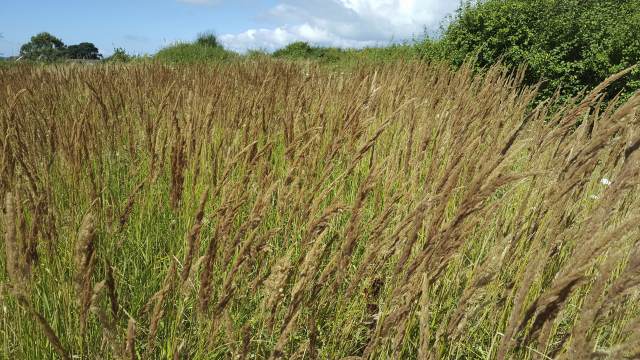
SATURDAY JULY 30 - 2016 - Kingley Vale
Heather Mills reported on this morning's walk by the Havant Wildlife Group:9 met up in Kingley Vale on a decidedly wet morning. We waited for a while before deciding to go regardless of the weather. Then it cleared slightly. Our most exciting find was to stand in the car park listening to a Turtle Dove. However, we did not see it. Twice it sang, along with Nuthatch calling and a Great Spotted Woodpecker. A Kestrel sat high up in the Oak along with a Buzzard. Further along the footpath we disturbed two Roe deer in the field alongside the footpath. A Yellowhammer chirped from its usual spot as we neared the entrance. Once into the reserve the rain again descended so there was very little bird activity and no butterflies either. One Meadow Brown seen.
We met a couple who regularly sit at the dew pond early on, whom we had met up with last year. They had watched a young fox play chase with two deer, and confirmed a sighting of the Turtle Dove, but it appeared to be only one. They thought that it was not as heavily marked as a male. I wondered if females sang as well as males. However the internet states that the female is not as "vocally talented" as the males. Unfortunately I did not get to hear it long enough to give a proper appraisal as to whether it was male or female. and would need another trip to find out if there was more than one. Perhaps someone will tell us who frequents this area and may read this.
Grasses have out-competed the wild flowers which were still very much in abundance, with delightful Harebells and Eyebright in amongst the Field Scabious. We deliberated over fruits in the tree that we sheltered under only to note later that it was Common Buckthorn. A Walnut tree along the main route had an abundance of fruits. We started and finished in the rain. It was bone dry when we returned to Portsmouth!!
SATURDAY JULY 9 - 2016 - Portsdown Hill
Ros Norton reported on this morning's walk by the Havant Wildlife Group
"Today a group of 12 met in car park near the Churchillian for a walk going west on a lovely sunny warm morning. We started around back of Fort Widley then crossed the road and walked west to roundabout.
Butterflies were active early and we saw many marbled whites and meadow browns, also comma, red admiral, whites, gatekeeper, large and small skippers and small tortoiseshell.
Other insects included bush -cricket, green thigh beetles, 7 spot ladybird, soldier beetles, bees, a blue hawker dragonfly and a lacewing.
Highlight was a distant sighting of 3 hares in a field.
Yellowhammers and greenfinches were singing well. Other birds included blackcap, stock dove, jackdaws, swallows, linnets and goldfinches.
There was an amazing variety of flowers especially yellow hawkbits and greater knapweed. Too many flowers to list all but they included bladder and white campion, a bee orchid, many pyramidal orchids, common spotted orchids, golden or tall melilot, Lucerne, rest harrow, kidney vetch and tufted vetch. There was upright hedge parsley, masses of hogweed, wild carrot , wild parsnip, field and small scabious. vipes's bugloss, ladies bedstraw, yellow-wort, common and lesser centaury, pale flax, fairy flax, harebells, nettle leaved bellflower, vervain, wild basil, marjoram, hedge woundwort, yellow rattle, musk mallow, and mignonette.
SATURDAY JULY 9 - 2016 - Holly Hill ReserveFay Durant reported on yesterday's walk by the Havant Wildlife Group
Eight of us met in the car park by the mouth of the River Hamble . It was a cloudy but warmish day . We had not, however, expected the wind to be such a problem. On our return journey it was almost gale force and made walking very unpleasant. The birds seemed unaffected and we were pleased to see a number of black tailed godwits along the shore line. On our return a group of approx 30 were seen, close to the car park. There were also several herons, little egrets, curlew, a Whimbrel, identified by Heather, a few oystercatchers and redshanks - some seen among the mud flats.
The flowers were eye catching: common mallow, tree mallow, attractive bushes of burnet and field rose, the striking fruiting heads of crow garlic and splashes of sea lavender along the shore.
We entered Holly Hill Reserve at the top and had coffee by the tree fern lake . A family of very young moorhens was spotted and the parents seemed to be gathering building materials for a nest! The tree ferns were looking very good. A fine collection of trees, some quite difficult to identify.
Unfortunately there wasn't time to visit the lower lake. Blackcaps were singing well , as we retraced our steps and one red admiral was spotted, otherwise very few butterflies were seen.
SATURDAY JULY 2 - 2016 - North Hayling
Heather Mills reported on this morning's walk by the Havant Wildlife Group:Seven met this morning on a sunny morning with a good stiff breeze blowing. The Marbled Whites were coming thick & fast in the vegetation beside the main footpath, as we set off, together with Large White and Meadow Browns not so prominent. Green Veined White and a large Skipper with a Comma seen later on.
Lots of grasses to take note of, but we only identified a couple, namely Yorkshire Fog and False Oat-grass. The lower field which is not accessible has a swathe of grasses but we could not see for certain what varieties there were. Goat's Rue was very prominent on this site and Sea Lavender. Biting Stonecrop, yellow Toadflax and Creeping Thistle also provided a spectacular visual display, the latter covered in many different types of bee, and hoverfly. Two Pyramidal Orchids seen. One hidden beneath a bramble and one spectacular specimen in the middle of the spare ground at the back of the houses.
As we began the walk a bird, of note was a Sedge Warbler singing in the bushes. Two close Curlews, and at least six Lapwing, some of which looked like juveniles, with Redshanks roosting on the small banks out in the channel, along with Black headed Gulls, and two Mute Swans, and a Great Black backed Gull. A Sandwich Tern gave a wonderful diving display as we enjoyed a break on the return and was joined by one other. This area at least 3 families of Greenfinch with young and Linnets and Goldfinch as well as House Sparrows and a couple of Whitethroats. Surprising not to see one Swallow or Swift. Cormorants, Crows, Wood Pigeons and a few Starlings.
Photos from Derek
SATURDAY JUNE 18 - 2016 - Portsdown Hill - east
Ros Norton reports on this morning's walk by the hwg
A group of 6 met at car park near The George at Portsdown Hill and were joined by 1 more later on a cloudy, mild and dry morning. We walked east to area around Fort Purbrook. A squirrel and rabbit ran along the path ahead.
Birds seen or heard included kestrel, buzzard, whitethroat, blackcap, greenfinch, goldfinch, chiffchaff , long tailed tits, wrens and swifts.
Some butterflies seen included marbled whites, a ringlet, a small blue and common blues.
Highlight was the flowers which included many pyramidal and common spotted orchids. Other flowers included a knapweed broomrape, black knapweed, common gromwell, kidney vetch, birdsfoot trefoil, tufted vetch, vipers bugloss, common toadflax, sainfoin, red valerian, rosebay willowherb, hogweed, dogwood, rockrose, hedge bedstraw, cut-leaved cranesbill, yellow-wort, quaking grass, mouse-ear hawkweed, agrimony, weld, wild mignonette, bladder and white campion. and yellow-wort.
We walked around a meadow south of the road but here the grasses seemed to be winning the battle as less variety of wild flowers here than usual.
SATURDAY JUNE 11 - 2016 - Noar Hill
Heather Mills reports on this morning's walk by the Havant Wildlife Group7 met on a somewhat dull start to the morning with slight drizzle in the air. We were met with the delightful song of Skylarks and Yellowhammer. As we made our way up the usual south easterly track a Great Spot was constantly calling. The Common Spotted orchids were much in evidence along with Pyramidal & Fragrant, together with a very good selection of Twayblades all over the site. Woodruff and Sanicle throughout more shaded parts of the woodland with Goldilocks found by Ros. Rock-rose and Fairy flax dotted amongst the daisies & buttercups. Brooklime was evident on the bridle path. Dog Rose & Elder flowers were abundant. A few remaining Early Purple Orchids were also seen.
Dragon's teeth were seen further into the reserve. A special lookout for Fly Orchid did not disappoint. However the site was somewhat trampled by previous visitors, being careless gaining access to the rarer version of the Green only flower, although most had a hint of brown. Dave very kindly showed one visiting lady from Dorset where to look as she was in the wrong pit. Very few birds to speak of however, we did get up to 4 Yellowhammers throughout. We also caught up with the calling Great Spot juvenile at the end of the walk. Birds very elusive this morning. Only later did we glimpse a Whitethroat and Bullfinch. Speckled Wood, Large skipper, Small Heath, & Common Blue were the only butterflies seen along with a few day flying moths. Maybe of interest to others who have Tree bumblebees, so I have included a photo of one. They first arrived 2 years ago but did not nest last year. Flowers & butterfly from Derek
SATURDAY JUNE 4 - 2016 - Petersfield Lake
Heather Mills reported on this morning's walk by the Havant Wildlife GroupEleven met on a cloudy morning to be guided by Ken around his local patch in Petersfield. We walked along the former golf course and saw evidence of a bronze age dig being undertaken. The finds are in the museum.
Every one of us commented on the amount of bird song, especially Song Thrushes & Blackcaps, one male serenaded right in front of us. 39 species seen. Families of Tree creeper gave some a fleeting chance to see the juveniles being fed, as we took a break in the woods next to the river Rother. Further along a fresh Beautiful Demoiselle gave good views with a female close by. Dave looked for the pink Purslane that was abundant in the woods along with a white variety at the entrance. Yellow Archangel and a good showing of Foxgloves with Pink Campion. Brooklime was another plant not often seen on our walks and possibly Heath Bedstraw. A garden escape kept us busy with I.D. and a huge leaf on the bank of the river reminded me of Gunnera. Fresh Dryad's saddle fungi in evidence with a vibrant yellow slime mould on one branch.
As we ended and looked across Petersfield lake there were abundant hirundines feeding well including Sand Martins and House Martins. A Reed Warbler flitted below our feet and apparently was breaking off tops of the reeds with difficulty for nesting. The Egyptian Geese had goslings.
SATURDAY MAY 21 - 2016 - West Hayling
Ros Norton reported on this morning's walk by the Havant Wildlife Group.
A group of 10 did an anticlockwise circular walk around West Hayling via Kench, Ferry and Gunner Point on a lovely warm sunny morning. Few birds included whitethroats, greenfinch, chiff chaff, a cormorant, common tern and skylarks.
The warm weather brought out a red admiral, common blues, white butterflies and a burnet moth. Two groups of striped caterpillars seen, likely lackey moth . A tree lupin was covered in aphids and one ladybird was seen.
A large number of plants were in flower including lots of tree lupins, and sea kale. Green winged orchids were going over and also bur chervil. A few little robin plants were in flower on the beach . Other flowers included cats ear, mouse ear hawkweed, beaked hawksbeard, sea mouse-ear, sea sandwort, sea campion, sea radish, English scurveygrass, English stonecrop, thrift, hoary cress, spring beauty, tree mallow, foxgloves, common storksbill, woody nightshade white bryony, hop trefoil, birdsfoot trefoil and harestail grass. There were many other flowers.
SATURDAY MAY 21 - 2016 - Pagham Harbour
Heather Mills reports on the Havant Wildlife Group walk
The weather forecast was not appealing today but it turned out to be better than expected as 5 walked around Pagham RSPB reserve.
55 species seen with a couple heard. The car park is always good for Blackcap, Chiffchaff, Wren, & Blackbirds all singing. As we set off to view the ferry pool, we were disappointed to see the level of water drastically reduced due to a breach, which is being attended to. There were a few Black-tailed Godwits and Redshank feeding but no sign of any Avocets at this point. A family of Mute Swans were on a mud bank and showed us their cygnets tucked under the wings of the parent.
The Reed Buntings and Warblers were singing well but we did not see many other birds apart from Shelduck in the distance. One lone Whimbrel seen far off with what I could only describe as a lone Grey Plover without summer plumage. After an eventful coffee break we resumed the walk out to the footpath going to Church Norton. As we proceeded along there were abundant Reed Buntings with Sedge and Reed Warblers every few metres. Red legged Partridge fed in the fields alongside and we were lucky to spot 2 Lapwing chicks also. A Common Tern avidly dived on the seaward side. When we retraced our steps a Yellowhammer appeared. Skylarks & Common Whitethroat were very obliging. A fresh Common Blue butterfly and Blue tailed Damsel Fly appeared.
The end of the walk gave us a fantastic view of the Mute Swan family carrying her 7 cygnets on her back and 7 Avocets had turned out on the ferry pool to preen.Red & White Campion, Greater Celandine, White Deadnettle,Germander Speedwell, Garlic Mustard, Red Clover, Gorse, possibly Lesser Stitchwort, and May trees out in abundance.
SATURDAY MAY 14 - 2016 - Titchfield Haven
12 people gathered at Titchfield Haven on a sunny morning.
Heather spotted 4 Gannets with their yellow heads out at sea off the IOW, and kindly let us see them through her scope. Along the sea shore path we saw Turnstones, a Woodpigeon and a Magpie. We walked round the West side first and had great sightings of Swifts, Swallows, a few Common Terns, and a Buzzard above us. A Whitethroat posed for us, Linnets were seen, a Mallard showed off her many ducklings. Blackcaps, Cetti's warbler, Reed bunting and Sedge warbler were seen & heard.
Some of us were lucky enough to see a water vole.
From the hides we saw Avocets, Oystercatcher, Canada geese with young, Black headed gulls nesting, & chicks, Redshank, Moorhen, Coot, Shelduck, Gadwall, Black-tailed Godwit in summer plumage, Shoveller, Cormorant and Heron.
Flowers seen were Marsh Marigolds, Ragged Robin, Yellow Archangel , Yellow Iris.
A female orange tip butterfly was seen on Hemlock Water Dropwort.
A few of us carried on after lunch and first saw a scrap between a Crow and 2 Lesser Black Backed Gulls fighting over a stolen egg. Then a bewildered fox with a mouth full of 2 Goslings. We think that she wanted to return for maybe a third gosling and was so undecided, namely because her mouth was full, that she eventually retraced her steps, before carrying onto the next field.
SATURDAY MAY 7 - 2016 - Stansted Forest
Heather Mills reports on this morning's walk by the Havant Wildlife Group"Six met to take a stroll around Stansted via the Rough Ride and towards Rosamund's Hill. The car park had a variety of birds, with Coal Tits, Song Thrush, Chiffchaff & Wren belting out their songs for us to enjoy. A pair of Long-tailed Tits were very vocal & Blackcaps seemed to be everywhere singing as we progressed, with a few Stock Doves and Bullfinch heard. Although we did not see a lot of species the spectacle of Bluebells made up for it. Yellow Pimpernel, Herb Robert, Yellow Archangel, Bugle, Ground Ivy, Crosswort, Tormentil, Celandine, Dog's Mercury and Wood Spurge all in abundance. Butterflies seen were a fresh Red Admiral, Brimstone, Small White, Orange Tips .As we enjoyed a coffee, the distinctive call of Ravens were heard towards Lumley."
SATURDAY APRIL 30 - 2016 - Old Winchester Hill
Ros Norton reported on this morning's walk by the Havant Wildlife Group.
"A group of 15 met on a lovely sunny morning and heard blackcap and chiffchaff from the car park. Just outside we heard a chiffchaff doing a part willow warbler song. Strangely we heard same last year from same place. (Brian's note - It must be the same bird?).
The birds were singing well and it was a pleasure to hear many willow warblers. We had good views of a yellowhammer and a skylark on the ground. Other birds singing included whitethroat, chaffinch, dunnock, green woodpecker, robin, wren and greenfinch. Some saw linnet, long tailed tit, kestrel and buzzard. During our coffee break we saw several hares running in a distant field.
Apart from abundant blackthorn flowers and cowslips mostly in bud, there were few flowers These included ground ivy, garlic mustard, dog violets, crosswort and dandelions. A small tortoiseshell butterfly posed on a sheltered path."Heather Mills added: "I was delighted to find a Chiff/Willow singing from the car park as soon as we arrived. Some of you may remember that I was confused by the bird starting with a Chiffchaff song last year. It then continued with a rendition of a Willow Warbler and back again to Chiffchaff. I did get a photo of this bird (on the left below) and a very confiding Willow Warbler for comparison (on the right). The WW appears much brighter yellow around the throat and the eye stripe is more noticeable. Yellowhammer and Skylark too. "
Last year Ralph Hollins commented on the mixed warbler song as follows:
"I have come across several reports of this behaviour over the years and after having another look at the internet I see that the general opinion seems to be that these birds are the result of interbreeding between their parents rather than songs 'learnt' by the bird from hearing the songs of the two species when they are young.
In addition to the link (to deanar.org.uk) which Brian sent you might like to look at http://www.digitalwildlife.co.uk/artical/sandychiff.htm for a local occurrence at Sandy Point on Hayling and also to http://gwentbirding.blogspot.co.uk/2011/04/theyre-everywhere.html
SATURDAY APRIL 23 - 2016 - Portchester
Fay Durant reported on the Saturday walk by the Havant Wildlife GroupEleven of us met up at Portchester Castle on a dry but very cold morning . The first excitement of the morning was the sighting of a grey wagtail , flitting up and down the moat . Looking out to sea were various gulls and a number of oystercatchers . Examining the castle walls , there were many small wild wallflower plants in full flower , a lovely shade of yellow . Ros said this was an important site for the flower , as it is rarely found in Hampshire . There were also Red Valerian plants in flower , amongst the wallflowers .
Then the highlight of the day , a whimbrel noted at the waters edge , then another , six then seven until the final gathering , on a split , of thirteen ! It was the first good sighting for many , so a moment to remember .
Photo by Heather MillsWalking south , along the coastal path , a chiffchaff was seen in a little woodland ; further on a great gathering of crows . Turning up Hospital lane masses of three cornered leek were seen , with patches of bluebells . Along the lane some very nice white comfrey plants , plus green alkanet . Interesting discussion over the various names for the arum lily : lords and ladies etc. Plenty of red dead nettle plants and later white .
We crossed castle street and along a path beside a cottage to the recreation ground , where a blackcap was heard .
Progressing north , along the coastal path , where the whimbrels were seen again . Fine plants of alexanders in flower , also cow parsley , one plant with very deep coloured leaves . At the top of the path an egret was seen in the ditch then another in a tree against dark green foliage , very striking . The last , satisfying viewing , was a white throat in a cherry tree . Quite a morning .
SATURDAY APRIL 16 - 2016 - Staunton Country Park
Chris Cope reported: 6 of us met at the entrance to Havant Thicket only to find the gate locked (nothing on the web site, I had looked last night, & no notice to explain why) So we went to Staunton Country Park. We heard Greenfinch, Chifchaff, Wren, Blackbird, Blackcap & Nuthatch, saw English & Spanish Bluebell, Wood Anemone, Wood-sorrel, Celandine, Primrose, Common dog-violet & 1 Snake's-head Fritillary. A hail storm followed by rain cut short our walk.
SATURDAY APRIL 2 - 2016 - Alver Valley
Report by Tony Wootton
14 of us went out on a warm, sunny spring morning, and saw the following.
Mallard, grey heron, sparrowhawk, buzzard, kestrel, moorhen, coot, BH gull, herring gull, wood pigeon, collared dove, green woodpecker, GS woodpecker, skylark, meadow pipit, dunnock, robin, blackbird, song thrush, heard a cetti's, chiffchaff, goldcrest, longtailed, blue and great tits, jay, magpie, crow, chaffinch and greenfinch. 30 species.
Flowering plants, alexander, cowslip, greater stitchwort, red dead nettle, more coltsfoot than anyone can remember, butchers broom, ivy leaved speedwell.
Insects, small white, 6 male brimstones, red tailed bee and a beefly.
SATURDAY MARCH 19 - 2016 - Brook Meadow
Report by Brian FellowsI was very pleased to meet up with several members of the Havant Wildlife Group in Bridge Road car park at 9am this morning to lead a walk through Brook Meadow. This is the only walk I now regularly lead for the group, so it was good to meet up with many of my old friends whom I see so rarely these days. The group is still going strong after 21 years - it was first established by Ralph Hollins in 1995. I still receive weekly reports of the walks, which take place throughout the year, in all weathers, and which I publish on the specially designated web page.
While we were in the car park we heard a Blackcap singing from the bushes at the end of the St James Road gardens. I explained that I have heard this bird several times recently and suspect it is a winter visitor rather than an early migrant. We did, in fact, keep an ear out on Brook Meadow for migrants, particularly Chiffchaff and Blackcap, but heard nothing. Are they a bit later than usual this year?
We walked up Bridge Road, stopping briefly at my home for Jean to say hello to the group, and then made our way up Victoria Road and down Seagull Lane to Brook Meadow. On the way Ros Norton identified a small flowering Hairy Bittercress growing on the pavement.
We noted the regular flock of House Sparrows chirruping away at the end of Seagull Lane. We looked at the Jubilee hedgerow which was growing very well and noted the first Blackthorn flowers.We walked round the north path to the north-east corner where we heard and saw several resident birds including Blue Tit, Great Tit, Long-tailed Tit, Coal Tit, Wren, Robin and Dunnock. A Cormorant flying overhead going north was an unusual sighting; we wondered where it was off to? Some inland lake maybe. We also saw a Kestrel taking off from the Lumley copse. This will be a resident bird and frequently seen around the meadow.
Heather spotted a Deer hoof mark in the mud on the east side of the meadow. A wandering Roe Deer is seen occasionally going through the meadow, probably coming from the railway embankment. The Gorse was flowering well on the causewayWe looked for Kingfisher when passing Peter Pond, but there was no sign of one, though we did see a Grey Heron flying off from the pond. The first local Cow Parsley was just starting to flower at the start of the path from Peter Pond to the south bridge.
We had our coffee break at 10.30 at the main seat. Thanks to Tony for taking the photo.
From there we had a look at the Butterbur spikes which are abundant in the area immediately below the seat. I shall need to do the annual count soon as many are going over. For full details of counts over previous years see . . . http://www.brook-meadow.hampshire.org.uk/bm-plant-counts.html
SATURDAY MARCH 12 - 2016 - Southmoor
Heather Mills reports on this morning's walk by the Havant Wildlife Group"Sorry if you missed this morning's walk. I was very pleased that 7 others joined me on such a pleasant morning. 52 species seen. The morning began with Hedge Sparrow singing and 3 Robins in the car park. We ascended the mound and took a good long look seaward. The Tide was coming in and the edges were awash with Curlew and a few dozen Brent, intermingled with Turnstones and Redshank and Dunlin. A possible Slavonian Grebe showed once or twice. Too small for Great Crested which could be seen on the water and too big for Little Grebe. Two Mediterranean Gulls mewed above us and would do so all morning. Derek spotted the Short-eared Owl over one of the islands hunting frantically. We progressed to Budds farm pool to see the usual birds taking a wash with a pair of Mute swans mating. We made ourselves comfortable on the seat provided and had a Goldcrest in one of the bushes. Two Long-tailed tits were busy catching flies and busy reconnoitring the area to nest. Greenfinch sang with Goldfinch and a Cetti's warbler. We eventually moved off noticing the Comfrey in flower along the footpath. As we moved in an easterly direction I did hope to have our first Skylark and sure enough one popped up and sang to everyone's delight. Shortly followed by a Meadow Pipit on the fence who also did a flight song in front of us. However, we were very soon distracted from that by a smart male Reed Bunting, who delighted us by sitting on the fence to get close views. As we neared the end of the southern part of the shore it was good to see the ringed Greenshank who just happens to be the one in Tony Wootton's picture. This was in the little stream of water that flows out from Southmoor. It was joined by 52 Red Breasted Mergansers completely at ease on a flat calm sea. A Great Spotted Woodpecker was heard drumming as we moved north and made our way back noting the Cherry Plum in flower, with House Sparrows very much in evidence around the industrial site.
I think it would be best to say that the 26th of March walk be cancelled as a replacement leader is not evident.
SATURDAY MARCH 5 - 2016 - Staunton Country Park
Ros Norton reported on this morning's walk by the Havant Wildlife Group.
A group of 9 met in Farm Trail car park for a walk on a sunny but cold morning. We walked along Cedar Avenue past Gipsies Plain where a highlight was a flock of redwings and a buzzard in a field opposite. There were other buzzard sightings on today's walk. Walking around the lake we saw a cormorant, coot, moorhen and several mallards. A grey heron was standing a field nearby.
Woodland highlights included Siskins, nuthatch, Great Spotted Woodpecker, green woodpecker, jay, Treecreeper, Goldcrest, goldfinch, long tailed tits and coal tits. In the fields some stock doves were among the wood pigeons and both mistle and song thrushes seen. Great tits and greenfinches were singing and jackdaws calling. Grey squirrels were the only wild mammals seen.
There were few flowers but these included hazel and sallow catkins, gorse, red deadnettle, dandelions, lesser celandines and a flower on butchers broom and primroses.
SATURDAY FEBRUARY 27 - 2016 - Cams Hall
Heather Mills reported on this morning's walk by the Havant Wildlife Group
"On a cold morning with a brisk easterly wind 8 set off to see the delights of Cams. I shall start with the plants in flower for a change. Red Dead-nettle, Celandine, Cherry-plum, Dandelion, Butcher's Broom. We paused to look over the bridge at a close Greenshank. Further up the footpath there were sightings of one or two Redshank. Whilst the groups of Wigeon numbered in dozens both sides of the creek. Teal with small flocks of Black-headed gulls and Mallards. We had a very long look at a male Goldeneye which was feeding in the middle of the creek, together with another male which ventured closer to shore, with one female. One distant Kingfisher across on a sluice, with another seen by one member later on. Six Little Grebes in the lower end of the creek were joined by others busily diving. Birds singing were Blue & Great Tits with Goldfinch and Greenfinch. The Brent Geese were evident towards the Portchester end of the creek flying about as the tide changed. 36 species seen with both Green and Great Spotted Woodpeckers, the latter seen drumming.On a sad note, I have read that Richard Hedley had passed away in January, and as a group would like to send our condolences to Jean. Richard guided our group around Browndown in the distant past and shared his wealth of knowledge in talks that we attended."
SATURDAY FEBRUARY 20 - 2016 - SW Hayling
Chris Cope and Ros Norton were the only ones to attend this morning's Havant Wildlife Group walk around Sinah Common. Chris says, "It was 11oC but felt much colder in the strong south westerly wind. Ros heard a Robin, Blue tit & Goldcrest in the thicket to the east of the parking area, there were 3 Great Crested Grebes on the gravel pit and Brent geese. Oystercatchers and a flock of Dunlin at the Kench. On the way back we saw a flock of Greenfinches on the golf links fence. There were a few flowers out :- Creeping Buttercup, Daisy, Alexanders, Cherry-Plumb, Field Speedwell, Sea Mayweed & Red Deadnettle.
SATURDAY FEBRUARY 13 2016 - Farlington Marshes
Sue Hill reported on Saturday's walk by the Havant Wildlife Group
Five of us braved the stormy sky and winds on Saturdays walk. We arrived near to high tide and were treated to a hovering Kestrel and a Alexander plant in flower in the car park. The plan initially was to explore areas north of the motor way and then the main marsh but hoping to avoid worsening weather we started out against the wind along the west wall to the Lake. Throughout the walk there were hundreds / thousand of Brent Goose on the sea, the Lake, the Deeps, on the Main Marsh , Hayfield and flying overhead. Also many Oystercatchers, Lapwing and Black Headed Gull. Very few small birds just five Rock Pipit near the Point Field wall, Chaffinch, Starling, Blackbird. Crow, Magpie and Wood Pigeon. On the Lake and The Deeps Teal, Mallard, Moorhen, Coot, Pintail, Shelduck and Wigeon. A pair Gadwall in a small stream. We cut across the sheltered Point Field but sadly no Owls.
An amazing site met us as we searched the Harbour from the east wall. On the shingle bank leading out from the Point Tip were hundred Turnstone and Grey Plovers all battling for space and at times unable to made headway against the wind. Tonys photo lead to much discussion about a lone specimen flying amongst the flock which the group later concluded was a Bar-tailed Godwit.
On the Main Marsh Canada Goose, three Egrets, Red Shank, Curlew, Black Tailed Godwit, Turnstone, flock Golden Plover and Dunlin and Rabbits. With the wind behind us on the East Wall in the harbour three Great Crested Grebe, Mute Swan, Cormorant and Common Sandpiper. We then cut across the Slip Field and a Sandpiper flew in onto the pond. Following discussion and viewing Tonys picture it was thought to be a Green Sandpiper.Then a quick view of Peters Pond but although a few birds were singing it was difficult to identify their song with the noise of the cars and wind. The track to the stream and Aerial field proved excessively muddy and difficult to continue so we returned to the car park via The Hut and Bushes. Green Finch, Robin and Wren were heard. Also some flowering Gorse and Daisies seen but nothing new spotted. Thank you all braving the weather and as always my thanks to our talented 'spotters'.
SATURDAY JANUARY 30 2016 - Medmerry
Ros Norton reported on this morning walk by the Havant Wildlife Group
Today a select group of seven met at Medmerry reserve car park at Earnley and walked a 4 mile mostly circular route around the west side on a cloudy and windy morning at low tide.
There were many species of birds including kestrels, a buzzard, stonechats, yellowhammers, linnets, skylarks, meadow pipits, magpies, rooks, crows, a distant cloud of starlings, a large flock of lapwing, shelducks, coots, curlew, mallards, teal, wigeon, tufted ducks, black headed and herring gulls, pied wagtail, egrets, herons, shovellers, gadwall, reed bunting, robin, woodpigeon and a little grebe.
Flowers noticed included lots of gorse and one daisy.
Walking by the sea we found 2 clumps of goose barnacles attached to floating objects washed up . They are crustaceans and more than usual have been reported along the south coast this winter. Several egg cases of ray or hark species and one of whelk egg cases were found.
SATURDAY JANUARY 23 2016 - Stansted Forest
Chris Cope reported on this morning's walk by the Havant Wildlife Group
14 of us met in Stansted, it was foggy & 5 degrees C, by 11 o'clock the sun was coming through & on the way home the temperature had gone up to 11 degrees C. We walked the Western Downs Cycle route, then left past Oak Copse where we had a coffee break then returned past 'Lumley Seat'.
The following birds were seen :- Mistle Thrush, Song Thrush, Coal Tit, Bullfinch, Goldcrest, Blackbird, Robin, Dunnock, Blue tit, Green & Great Spotted Woodpecker, Wood Pigeon, Crow, Jackdaw & Raven. Buzzard, Jay & Nuthatch heard.
Cherry Laurel was coming into flower & we saw one Primrose, a Dandelion & Red Dead-nettle out.
We looked across the open fields in the hope of seeing a Hare and wondered where they go in winter, so this is what I've found about them:- They are mainly nocturnal, during the day they crouch low against the ground in scrub, grass or in a ploughed furrow, with their ears flat. Their breeding season is January to August - So why can they be seen 'Boxing' in March & April ? - perhaps they are just pleased to see the warmer weather! Their young Leverets are predated by Foxes, Owls & Buzzards, and the weed killers that are sprayed on the cornfields are believed to deprive them of many of the plants they eat.
SATURDAY JANUARY 9 2016 - Baffins and Salterns
Sue Hill reported on this morning's walk by the Havant Wildlife Group"Ten joined the walk today. Our route was around Baffins Pond then along Westover Road to Great Salterns Recreation Area. After refreshments one of the group left and the rest continued over the Eastern Road and along the Sea wall returning through Sword Sands Lane and the past the Brent Goose Reserve to Baffins Car Park. We were lucky with the weather - only experiencing some wind and one short drizzle of rain.
Baffins Pond: Lots of Sparrows & Starlings, 5 Long Tailed Tits, Few Dunnocks, 3 Gold Crest, Blue Tits, 6 Gold Finch, 2 Collared & several Stock Doves .
Lots of Tufted Duck, Mallards, Black Headed & Herring Gulls. Several Cormorants, Some Coots, Moor Hens, 3 Male & 2 Female Call Ducks. A pair of Shovelers, 1 Grey Heron, 1 Lesser Black Backed Gull, 3 Canada Geese & 1 White Goose. 2 Mute Swans. 3 very friendly Grey Squirrels but no sign of Water Rail or Terrapins. Plus Elder leaves, 2 Yellow Iris, Green Catkins & Snowdrops were showing.
Great Salterns Recreation Area. Gold Finch, Dunnock, Robin, Magpies, Crows, Sparrows, Blackbirds, 1 Great Spotted & 1 Green Wood Pecker, Song Thrush & Cetti were heard. Plus 1 Kestrel. Also Hog weed and Dead Nettle.
Sea Wall Area. Pied Wagtail, Red Crested Grebe, Common Herring & Juvenile Gull, Flocks of Oyster Catchers, Brent Geese (flying & swimming). 6 Turnstone, Red Crested Merganser, 2 Mute Swans & 4 Cygnets, Doves & Stock Doves, Starlings & a Great Tit. Daffodils, Violets, Daisies, Dandelions, Red Dead Nettle & Sow Thistle.
Brent Goose Area Possibly 1000 + Brents but no evidence of juveniles. Many Gulls & 2 Curlew.
Thank you all for a lovely walk and as always to our talented 'spotters'.
SATURDAY JANUARY 2 - 2016 - Langstone
Ros Norton reported on this morning's walk by the Havant Wildlife Group.
"Today an optimistic group of 8 gathered at Langstone at low tide on a showery, overcast and very windy day. The forecast was unpromising but we decided to go. Thanks to Heather for the pic.Along the stream by the mill was a greenshank, redshank and Wigeon. On the mill pond a pair of swans with five big cygnets, mallards, coots and moorhens were around and a heron flew into trees behind. There were many birds in the field to the east including several little egrets and herons by the back fence and teal, Wigeon, oystercatchers, a pied wagtail, woodpigeons and a flock of starlings in the grass.
Walking inland along Wade Court we came across an early flowering cow parsley. Further along were red berries of butchers broom and flowers of winter heliotrope. A muddy field was providing food for several little egrets. Both song and mistle thrushes seen, blackbirds great tit, blue tit and long tailed tits were along Wade Court. A few celandines were in flower along the road to the Arts Centre where we stopped for a coffee break.
Walking through the car park we came to a new small area planted for wildlife, Grove Copse. We followed the Billy Line back to main road and saw many birds including a grey wagtail, an egret, Goldcrest, blackbirds, a singing robin and a flock of at least 10 long tailed tits. A flowering shrub was thought to be possibly cherry plum.
We ended the walk earlier than planned due to heavy rain and it was considered too windy to go to South Moors and Budds Mound. However we saw a large number of birds in a smaller area without encountering muddy puddles.
Wishing everyone a Happy New Year."
FOR 2015 WALKS REPORTS GO TO . . Saturday Walks - reports 2015
